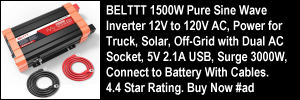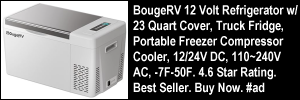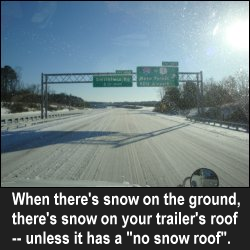 On April 11, 2018, Vicki Simons had an idea for a no snow roof, no snow trailer roof, no ice roof, or no ice trailer roof as she was reading an article about a trucker who was ticketed for having an overweight truck when he clearly showed a scale ticket showing that his truck had been legal.
On April 11, 2018, Vicki Simons had an idea for a no snow roof, no snow trailer roof, no ice roof, or no ice trailer roof as she was reading an article about a trucker who was ticketed for having an overweight truck when he clearly showed a scale ticket showing that his truck had been legal.
The trucker asserted with the Iowa DOT officer at the weigh station that the accumulated snow and ice on his trailer’s roof was to blame for being overweight.
To be honest, Vicki understood the situation from the perspective of both the trucker and the DOT officer.
Thinking Outside the Box About Snow on Trailer Roofs
That’s when Vicki asked out loud why trailer manufacturers don’t just design some kind of a thin network of wires that could be warmed to melt snow and ice off the entire roof of trailers.
- Her first thought was “like an electric blanket but without the fabric.”
- Then her second thought was “like a waterbed heater, except across the entire surface (full length and full width) of a trailer roof.”
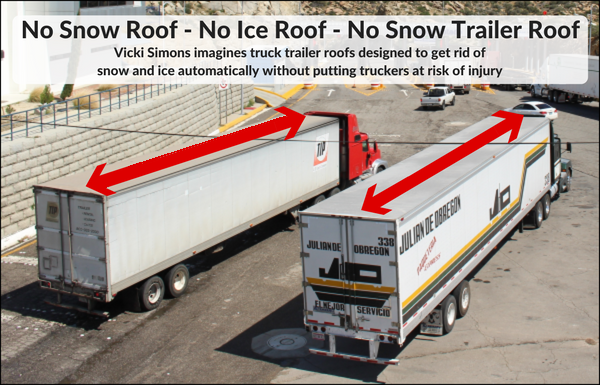
The Problems With Snow and Ice on Trailer Roofs
There are a number of problems with the current set-up:
 The height of a standard semi-tractor trailer commercial motor vehicle in the USA is 13’6″ (thirteen feet, 6 inches).
The height of a standard semi-tractor trailer commercial motor vehicle in the USA is 13’6″ (thirteen feet, 6 inches).
- How is a trucker supposed to get up there? Most truckers don’t carry ladders on their trucks.
- Assuming that a trucker can get up on the roof, how will he/she keep from falling through the roof or off the side?
- What happens if the ladder slips on the snow and ice on the ground?
- Most trucks don’t have — or don’t have access to — an overhead harness device to keep truckers from falling.
- With what tool will a trucker scrape the snow and ice off the roof without damaging it?
- While “roof rakes” can remove some of the snow from the roof of a trailer,
- it cannot possibly reach all of it due to the angle of the person working on the ground and
- the tools are not sturdy enough to remove ice frozen on the roof.
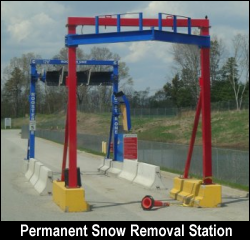 There are relatively few permanent snow and ice removal stations — and they may not be where truckers need for them to be.
There are relatively few permanent snow and ice removal stations — and they may not be where truckers need for them to be.- When snow rakes and motorized gizmos installed on top of trailers knock snow and ice off trailer roofs, mounds of the frozen stuff can wind up on the three sides of the trailer, making it difficult to walk around the trailer.
- There is the very real potential for injuring someone riding behind a commercial motor vehicle when snow and ice get knocked off the roof when the truck passes under an overpass. We address some of these on our snow removal page.
- More and more states are passing and enforcing snow removal laws.
Why Not Just Melt Off Snow and Ice?
An obvious solution is: Why not just melt off all frozen precipitation from a trailer roof?
Vicki imagines the design and installation of a thin waterproof “mat” with a low-watt heater screen embedded in it that will warm up the roof so that the snow and ice melts off — much like a waterbed heater.
To help you picture this device, here is one such waterbed heater listing from Amazon.com, with which we have an affiliate relationship.
By having such a heated trailer roof installed, the trucker can get rid of snow and ice automatically without having to
- go to a snow removal station or
- scrape it off manually.
Imagine a winter with no snow and no ice on your trailer roof
- either without intervention
- or at the flip of a switch (depending on the amount of frozen precipitation that needs to be melted).
Vicki thinks that having a device installed that keeps snow and ice melted without driver intervention would be great!
Potential Names of the No Snow Roof
- No Snow Roof
- No Snow Trailer Roof
- No Ice Roof
- No Ice Trailer Roof
- No SNICE Roof (“SNICE” being a combination of “snow” and “ice”)
- No SNICE Trailer Roof
- SNICE-Free Roof
- Automatic Snow Melting Roof
- Snow Away Roof
- Snow-Away Roof
- Snow-Free Roof
- Snow Melting Roof
- Heated Trailer Roof
- Automatically Heated Trailer Roof
Imagine how a trailer manufacturer could market their trailers with such a device installed:
- “We care about the safety of drivers in the winter.”
- “Now with our Snow-Free Roof design to keep drivers safe and legal.”
- “Experience no more problems with our Automatic Snow Melting technology.”
Potential Design Ideas for the No Snow Roof
Vicki is not an engineer and does not know how to go about designing such a device or tool.
However, she has driven a commercial motor vehicle (CMV) in the winter and has ideas about how such a device should be constructed.
- Network of wires on trailer roof
- Thin wires less than 1/8-inch high
- Like a screen for a porch
- Intersections close enough together to melt all snow and ice on roof
- Can be combined with solar panels on roof
- Capable of conducting electricity and heat
- Using a low-watt amount of electricity
- Similar to waterbed heater
- Light weight
- Mold and mildew resistant
- Does not need to be cleaned
- Perhaps made with clear or near-clear coating so that trailers made with roofs to permit light can continue to do so
- When installed, will not make height exceed
- 13’6″ on standard trailers or
- 14’3″ on high cube trailers
- Embedded in protective all-weather material to stand up well
- over a long time (many years)
- in extreme hot and cold temperatures
- Attached to the trailer roof
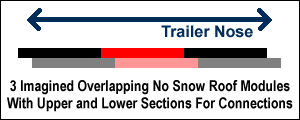 In a semi-permanent manner
In a semi-permanent manner- In modules (say 24″ x 36″) such that if one section of the heater goes out, the whole-roof heater doesn’t go out and the bad module can easily be replaced
- In overlapping layers such that things blowing over or bouncing off the top of the trailer (wind, leaves, hail, etc.) won’t dislodge them
- Powered by
- either connection with the tractor (requires lead time for melting to take place)
- or preferably a device attached to the trailer, such as
- Solar panel and power set-up or
- Small replaceable battery on the trailer’s nose
 Displays a “Module Map”
Displays a “Module Map”
- To show that the entire wire network is heating (lights up when working)
- To show integrity of network of wires (indicates which modules aren’t working)
- Unit turns on
- either automatically when
- Temperature falls to, say, 38 degrees F (need for thermostat?)
- When there’s a certain weight of snow or ice on the roof (requires additional sensors)
- or manually via a control mounted on the trailer’s nose
- either automatically when
- Safety features
- Does not require trucker to get on trailer roof
- Does not require manual snow removal
- When snow and ice melt
- Makes trailers compliant in states with snow removal laws
- Keeps additional weight of snow and ice off roof
- Trailers to install on
- Any trailer running where there is the possibility of snow and ice build-up
- Brand new trailers
- Old trailers (retrofitted)
- Requires roof design to permit snow and ice to melt off.
Placement for No Snow Roof Controls
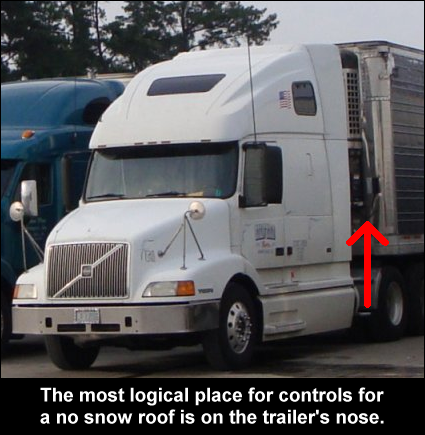 The most logical place for controls for a no snow roof on a trailer is on the nose, near where the driver hooks up his/her air hoses.
The most logical place for controls for a no snow roof on a trailer is on the nose, near where the driver hooks up his/her air hoses.
Your Feedback Is Requested
What do you think, truckers?
Would you like to have this kind of technology on the roof of every trailer you haul during snowy and icy weather?
We would like to hear your feedback — including any features that Vicki hasn’t thought of.
Also, if you want this technology on your trailer roofs, don’t keep this a secret! Share this page on social media and with your trucking company.
When there is enough of a demand, trailer manufacturers will find a way to make the “no snow roof” technology a reality.
Thanks in advance for sharing.
Published on April 13, 2018, by Vicki Simons.
Return from No Snow Roof – A Solution for Eliminating Snow and Ice on Trailer Roofs to our Truck Operations page or our Truck Drivers Money Saving Tips home page.




